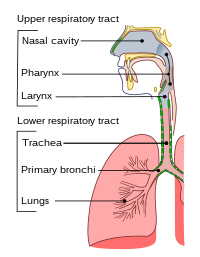
Photo from wikipedia
Background Bronchiolitis is the most common lower respiratory tract infection (LRTI) in children and is mainly caused by the Respiratory Syncytial Virus (RSV). Bronchiolitis presents seasonally and lasts about five… Click to show full abstract
Background Bronchiolitis is the most common lower respiratory tract infection (LRTI) in children and is mainly caused by the Respiratory Syncytial Virus (RSV). Bronchiolitis presents seasonally and lasts about five months, usually between October to March, with peaks of hospitalizations between December and February, in the Northern Hemisphere. The burden of bronchiolitis and RSV in primary care is not well understood. Materials and methods This retrospective analysis used data from Pedianet, a comprehensive paediatric primary care database of 161 family paediatricians in Italy. We evaluated the incidence rates (IR) of all-cause bronchiolitis (ICD9-CM codes 466.1, 466.11 or 466.19), all-cause LRTIs, RSV-bronchiolitis and RSV-LRTIs in children from 0 to 24 months of age, between January 2012 to December 2019. The role of prematurity (<37 weeks of gestational age) as a bronchiolitis risk factor was evaluated and expressed as odds ratio. Results Of the 108,960 children included in the study cohort, 7,956 episodes of bronchiolitis and 37,827 episodes of LRTIs were recorded for an IR of 47 and 221 × 1,000 person-years, respectively. IRs did not vary significantly throughout the eight years of RSV seasons considered, showing a seasonality usually lasting five months, between October and March, while the peak of incidence was between December and February. Bronchiolitis and LRTI IRs were higher during the RSV season, between October and March, regardless of the month of birth, with bronchiolitis IR being higher in children aged ≤12 months. Only 2.3% of bronchiolitis and LRTI were coded as RSV-related. Prematurity and comorbidity increased the risk of bronchiolitis; however, 92% of cases happened in children born at term, and 97% happened in children with no comorbidities or otherwise healthy. Conclusions Our results confirm that all children aged ≤24 months are at risk of bronchiolitis and LRTI during the RSV season, regardless of the month of birth, gestational age or underlying health conditions. The IRs of bronchiolitis and LRTI RSV-related are underestimated due to the poor outpatient epidemiological and virological surveillance. Strengthening the surveillance system at the paediatric outpatient level, as well as at the inpatient level, is needed to unveil the actual burden of RSV-bronchiolitis and RSV-LRTI, as well as to evaluate the effectiveness of new preventive strategies for anti-RSV.
Journal Title: Frontiers in Pediatrics
Year Published: 2023
Link to full text (if available)
Share on Social Media: Sign Up to like & get
recommendations!